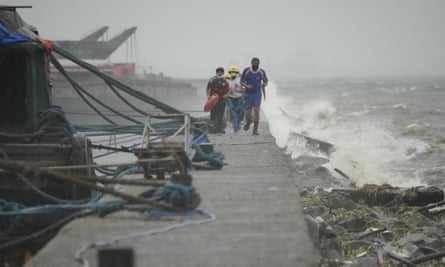Five rescuers have died in the Philippines after Super Typhoon Noru slammed into the north of the country, causing floods and power outages and forcing officials to suspend classes and government work in the capital and outlying provinces.
The most powerful typhoon to hit the country this year hit the coast in Burdeos town in Quezon province before nightfall on Sunday then weakened as it barrelled overnight across the main Luzon region. Thousands of people were moved to emergency shelters, some forcibly.
Incredible storm surge in Polillo, Quezon, Philippines which was hit by the eyewall of #KardingPH / #Noru.pic.twitter.com/TiSH4di3br
— Ben Noll (@BenNollWeather) September 25, 2022
Daniel Fernando, the governor of Bulacan province north of Manila, said five rescuers, who were using a boat to help residents trapped in flood waters, were hit by a collapsed wall then apparently drowned in the rampaging waters.
“They were living heroes who were helping save the lives of our countrymen amid this calamity,” Fernando told the DZMM radio network. “This is really very sad.”
On Polillo island in north-eastern Quezon province, a man was injured after falling off the roof of his house.

More than 17,000 people were moved to emergency shelters from high-risk communities prone to tidal surges, flooding and landslides in Quezon alone, officials said.
More than 3,000 people were evacuated to safety in metropolitan Manila, which was lashed by fierce wind and rain overnight. Classes and government work were suspended on Monday in the capital and outlying provinces as a precaution, although the morning skies were sunny.
The entire northern provinces of Aurora and Nueva Ecija, which were hit by the typhoon, remained without power on Monday and repair crews were at work to bring back electricity, the energy secretary, Raphael Lotilla, told the president, Ferdinand Marcos Jr, in a televised meeting.
Marcos praised officials for evacuating thousands of people to safety as a precaution before the typhoon hit, which prevented large number of casualties despite the Noru’s potentially disastrous force.

Noru underwent an “explosive intensification” over the open Pacific Ocean before it hit the Philippines, Vicente Malano, who heads the country’s weather agency, said on Sunday.
From sustained winds of 85km/h (53 mph) on Saturday, Noru was a super typhoon just 24 hours later with sustained winds of 195km/h and gusts of up to 240km/h at its peak late Sunday.

By Monday morning, Noru had sustained winds of 140km/h and gusts of 170km/h and was moving westward in the South China Sea at 30km/h, according to the weather agency.
In 2013, Typhoon Haiyan, one of the strongest recorded tropical cyclones in the world, left more than 7,300 people dead or missing, flattened entire villages, swept ships inland and displaced more than 5 million in the central Philippines.